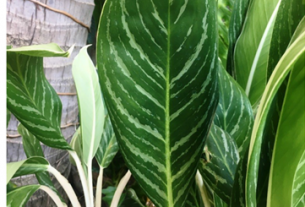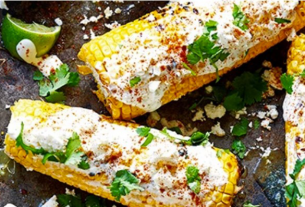By Tommy Clarkson on the July 2020 Edition
Bougainvillea Bougainvillea x buttiana
Family Nyctaginaceae
Also known as Paper Flower
 For many of us, this was the first non-potted, “tropical flower-ing plant” which – upon initially seeing it – we may have thought “Toto, I’ve a feeling we’re not in Kansas anymore!” For me, this happened in Hawaii, on R&R from Viet Nam, in 1967. These brilliant bushes seemed to be everywhere. They lined the street, filled the boulevard meridians and enthusiastically burst with color in every resident’s yard.
For many of us, this was the first non-potted, “tropical flower-ing plant” which – upon initially seeing it – we may have thought “Toto, I’ve a feeling we’re not in Kansas anymore!” For me, this happened in Hawaii, on R&R from Viet Nam, in 1967. These brilliant bushes seemed to be everywhere. They lined the street, filled the boulevard meridians and enthusiastically burst with color in every resident’s yard.
The genus derived its name from Admiral Louis-Antoine de Bougainville who saw the plants in Brazil during one of his several seafaring treks. This genus is rather small, consisting of some South American, spiny shrubs, trees and vines. For the most part, the originals grew in dry coastal areas or intermountain valleys. All of these share the common factor of having those small, tubular and short living, as opposed to its bracts flowers in somewhat of a cluster effect toward the ends of the stems. For the most part, it is the shrubbing and vining varieties that are most used in the United States and all are de-scendants of the Brazilian B. spectabilis, B. glabra and B. peruvi-ana. (An article on B. glabra was included in Volume II of “The Civilized Jungle.”)
All of these species, while much appreciated by those seeing them, are often misunderstood as to what many perceive to be its flowers. That which looks from a distance to be red, white, pink, purple, orange, yellow or white blooms are, actually,bracts modified leaves. The true flowers are quite small, having white petals face on appearing like a tiny daisy in the center of a colorful huddle of bracts.
 Botanically, these beautiful, cascading and somewhat vine-like bushes are a hybrid between the aforementioned B. peruviana and B. glabra. They come in a dazzling array of names and col-ors. Drawing liberally from the experience and expertise of Robert Lee Riffle and his wonderful tome, The Tropical Look, some examples of these “rainbowesque” colors include: ‘Apple Blossom,’ a medium sized bush of white bracts flushed with rose; ‘Golden Glow,” a large vine of brilliant yellow-gold;
Botanically, these beautiful, cascading and somewhat vine-like bushes are a hybrid between the aforementioned B. peruviana and B. glabra. They come in a dazzling array of names and col-ors. Drawing liberally from the experience and expertise of Robert Lee Riffle and his wonderful tome, The Tropical Look, some examples of these “rainbowesque” colors include: ‘Apple Blossom,’ a medium sized bush of white bracts flushed with rose; ‘Golden Glow,” a large vine of brilliant yellow-gold;
‘Hawaiian Yellow’ with pure yellow; ‘Mrs. Butt,” sporting intense red; ‘Phoenix”, like ‘Mrs. Butt,’ however having variegated leaves, ‘Texas Dawn’ an open growing vine of light purple; ‘Cypheri,’ a large, fast growing specimen of “deep, almost glowing, purple”; ‘Easter Parade’ of, appropriately, light pink; and, ‘Singapore Beauty’ dense and large, colored in magenta.
 Why try to say something another has already articulated well? Hence, once again, I quote Mr. Riffle, “All (of) the vining types in cultivation have long and rangy, thorny canes with mostly dark greenheart shaped leaves that are often pubescent with reddish or bronze young growth. A few cultivars have foliage beautifully variegated with cream or white (but) these do not grow as large as the non-variegated types.”
Why try to say something another has already articulated well? Hence, once again, I quote Mr. Riffle, “All (of) the vining types in cultivation have long and rangy, thorny canes with mostly dark greenheart shaped leaves that are often pubescent with reddish or bronze young growth. A few cultivars have foliage beautifully variegated with cream or white (but) these do not grow as large as the non-variegated types.”
Bougainvillea plants like well-draining, even sandy, soil. They want full sun and regular watering when not flowering. I’ve encountered numerous gardeners who assert that these plants need lots of water when blooming. I have found success by providing a more moderated amount of moisture, as they seem to show more color when slightly stressed. Perhaps the best counsel might be summed up as “regularly, but not excessively.” Some species can grow quite long vines – up to fifty feet (15.24 meters). Every so often, my breath is taken away when coming upon one that has clamored through and high atop a tall tropical tree.
To keep them at a particular size, frequent and rather aggres-sive pruning is no problem. The cutting of the canes is not det-rimental to flower and bract production as they bloom on new wood. Such cutting should be done after the current crop of color has faded. Fertilize regularly, but sparingly. Take your time in moving them from one pot to a larger one, as root-bound specimens tend to flower more abundantly. When transplanting, be extra careful, as they do not recover well from broken roots. Maintain a watchful eye on its new growth for mealybugs and aphids.
Nellie Neal – whose comments and information I so enjoy- wittily wrote in her book, “Gardner’s Guide to Tropical Plants,” (and probably only those of us from, shall we say, the older set, will know of whom she spoke) “The magnificent performer Carmen Miranda was known as ‘The Brazilian Bombshell,’ but to gardeners, Bougainvillea plants in full bloom present stiff competition for that title.”
—
Tommy Clarkson is a bit of a renaissance man. He’s lived and worked in locales as disparate as the 1.2 square mile island of Kwajalein to war-torn Iraq, from aboard he and Patty’s boat berthed out of Sea Bright, NJ to Thailand, Germany, Hawaii and Viet Nam; He’s taught classes and courses on creative writing and mass communications from the elementary grades to graduate level; He’s spoken to a wide array of meetings, conferences and assemblages on topics as varied as Buddhism, strategic marketing and tropical plants; In the latter category he and Patty’s recently book, “The Civilized Jungle” – written for the lay gardener – has been heralded as “the best tropical plant book in the last ten years”; And, according to Trip Advisor, their spectacular tropical creation – Ola Brisa Gardens – is the “Number One Tour destination in Manzanillo”.



